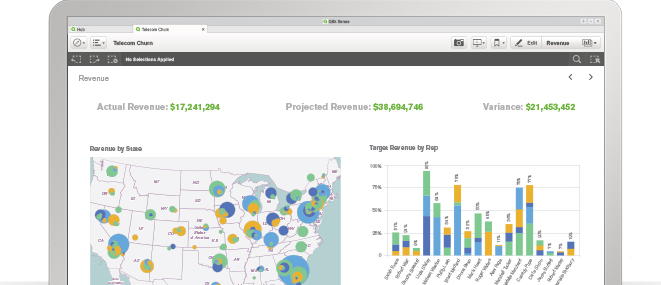As a QlikView blogger, it is hard for me to believe but year 2014 is in the rear view mirror. A lot has happened in 2014 for Qlik; not to mention that my passion to learn and share knowledge of QlikView with this blog has provided me many opportunities in the past year. For that, I am humbled and honored that you are taking time to read my blog. So, thank you!!!
Qlik has a new product in its arsenal to compete against growing competition from Tableau — QlikSense. If you haven’t seen QlikSense in action, now is the time to explore a new generation of self-service data visualization and discovery tool in action.
For those of us who are passionate about QlikView, it is amazing to see a spectacular growth of the self-service business discovery tool segment here in the States and around the world. The growth is evident from the fact that many major BI software companies have invested heavily into building next generation self-service data discovery tools. SAP Lumira, Microsoft Power BI and Microstrategy to name a few who are trying to capture a growing BI niche mainly dominated by Qlik and Tableau.
With that perspective, I’d like to share some of my most favorite Qlikview blog posts to keep you infromed in case if you miss reading these awesome articles. Please don’t be mislead by numbers given to each article as they all are equally informative and awesome.
1. Qlik Sense is not just a new release of QlikView. Instead it is something different. But there are still so many similarities between the two products, so I thought it would be appropriate to dedicate a blog post to differences and similarities between the two. —QlikView and QlikSense by Henric via QlikView Design Blog
2. The Qlikview Document Alert feature is generally thought of as a way to notify users or administrators of exceptional conditions in the loaded data. But it may also be used for regular emailing of non-exception conditions, like daily sales figures. — Using Alerts to Send the Numbers via Qlikviewcookbook
3. I often need random data. For example to use in an example file on this blog, to deliver a customer demo or just to test out something new. As I am probably not the only one with this need, here’s a short and sweet post on how to generate random data for use in QlikView. — Generating random test data in QlikView with Mackaroo via QlikFix
4. I was demoing a quick incremental load script earlier today so I thought I would share it here. — Easy Incremental Load via QlikTips
5. When searching the entire Internet for that bit of information that you can remember you read on a QlikView blog a while back; you are inevitably faced with many results that are not at all relevant. Questions from Qlik Community, vendors selling licences and even other BI app providers muscling in on the search results. That is why we have built AskQV – a more useful QlikView search engine. — Announcing the Launch of AskQV via Quickintelligence
6. I’m not sure why, but I’ve always wanted to embed a video in one of my Qlikview applications. The problem was I could never find a good reason to do so, until a week a ago. — Integrating Video in QlikView via Bi Experience
7. You’ve been doing this SET ANALYSIS thing for a while, and you’re are about to get serious about it. You might have tried SET ANALYSIS on your own & using QlikCommunity help. As a developer it’s important to use the common standard vocabulary while talking with fellow developers about the expressions/scripts. — Three Components of QlikView Set Analysis via QlikShare
8. QlikView application consists of 2 parts – Visualizations and Data model. Your visualization will display the underlying data.Therefore creating a robust Data model is key to any successful application. — Data Modeling in QlikView Part II via Learn All BI
9. Designing a dashboard takes some thinking upfront, sketches/wireframes/mockups are often used before we come up with a first prototype of any dashboard design and implementation. I often start with writing down a table of content (sitemap) for a design. — Steps in Designing a Dashboard via QlikShow
10. Flat UI has been the latest trend in interface design and many QlikView developers are adopting its principles in designing dashboards that are clean and easy to read. — Flat UI via IntuiQlik
In addition, there are many awesome articles you can read from any one of these awesome blogs to enhance your QlikView skills; and I need to give credit to those selfless community contributors who are spending endless hours to make you an awesome QlikView users and developers!
I wish you a greater success in 2015! Keep Qlikin!
photo by: Qlik.com






Steve Dark 9:16 pm on January 25, 2015 Permalink
Many thanks for the mention here, we are very pleased with how well AskQV has been received by the Qlik community.
Shilpan 12:55 am on January 30, 2015 Permalink
Steve,
AskQV was a brilliant idea so thank you for including my blog.
JV 10:35 am on January 26, 2015 Permalink
Hi Shilpan,
I’m glad one of my post is among those you found useful in 2014.
Cheers
JV
biexperience.wordpress.com
Shilpan 12:54 am on January 30, 2015 Permalink
JV,
I really enjoy reading articles on your blog. Many thanks.